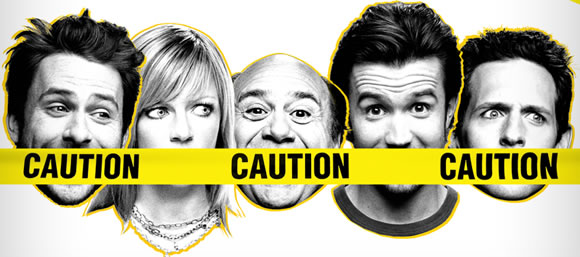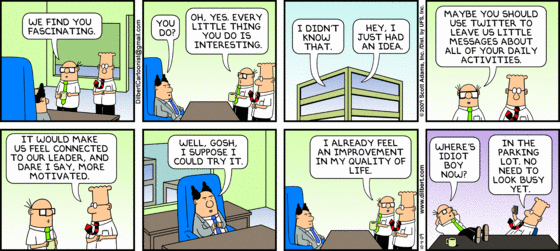Written by Gina Trapani
Last week we asked a simple question: How will you use Google Wave? Over 600 responses later, we’re sending Wave nominations to the people who had the best use cases. Here are a few.
Education: Increasing Interactivity and Collaborative Learning
Dozens of teachers, students, and academics of all stripes wrote in saying that they need better and faster ways to communicate and collaborate in and out of the classroom. Middle School Technology Coordinator Dov wrote:
I am taking part in a program called Powerful Learning Practices (PLP, or PlanetP, if you like). PLP is a professional development model that immerses educators into environments that allow them to learn literacies of 21st Century teaching. The goal is that the teachers bring this new paradigm of learning and teaching back to their schools, becoming its best advocates. While the impact isn’t as large as, say, the crew of the Enterprise saving a planet from Klingon destruction, it has the potential to affect thousands of teachers and students.
Sound dry? Dov created the animation here to illustrate the point. (Your invite is en route, Dov.)
Whether or not teachers know about Wave, students are chomping at the bit. High school junior Sean wrote:
In my AP European History class, my fellow students and I are always struggling to keep up with taking notes. After each class we all email each other the notes that we took, and it’s always up to us to compile all of the important info, and figure out the validity, etc. With Google Wave, we could have one master notebook, where we could verify all the info, highlight what will probably be the most important for the international exam, and just improve the process of studying completely.
Education might be the obvious place Wave could be put to good use. But readers in healthcare, journalism, transportation, research, disaster relief, and business want it, too. Here’s what they said.

Healthcare: Getting the H1N1 Vaccine Out Faster
Brian is a CDC consultant in Atlanta, GA. He wrote in:
My group is supporting H1N1 vaccine distribution, including planning, shipping, and communication. We have a team here in Atlanta, Department of Health and Human Services people in DC, and the distributor, based in Dallas. Also, the team in Atlanta is spread over 4 campuses. We use email, intranet, shared drives, etc. to collaborate. We meet CONSTANTLY, leading to lots of meeting recaps, duplicated work, and wasted time. As the situation changes (doses manufactured, quarantined, distributed, people infected, etc.), we are constantly updating plans and tracking numbers for reporting. Documents are stored in shared drives. Updates are sent via email. Wave would allow much easier tracking of changes to our documentation and communications. Before anything goes out the door, it has to be checked by 3-4 people after being worked on by another 3-4. If we could all work simultaneously on a message, it would greatly cut our time and thus get messages out to the public (or even to HHS, the distributor, or the manufacturers) much, much faster.

Transportation: Controlling Air Traffic
James is a Traffic Management Coordinator at the Philadelphia International Airport Control Tower. He said:
My job is to reduce departure delays and to maintain an efficient flow of air traffic into and out of the Philadelphia International Airport. Currently we utilize a Google Spreadsheet to share real-time departure and weather issues, airport construction updates, and snow removal operations with the airlines and other interested parties. I’m excited at the prospect of being able to embed real-time weather radar gadgets to provide users an up-to-the-minute graphical look at the weather. We currently use the chat feature on Google Spreadsheets but it appears that the more robust communication capabilities in Wave would greatly enhance our communication with the airlines. The ability to review conversations and data will help us to further reduce delays at Philadelphia International Airport. This will result in a savings of time for passengers, reduced fuel and operating costs for the airlines, and fewer complaints from both.

Journalism: More Complete and Collaborative News Reporting
Like education, collaborative journalism also seems like a natural fit for Google Wave. Interestingly, just as many student newspaper contributors wrote in for Wave invites as professional papers.
Casey is a reporter who covers government and politics at the Arizona Republic, the largest newspaper in Arizona (and one of the country’s 10 biggest, he says). Casey wrote:
Google Wave will be enormously useful to reporters collaborating on stories. Currently a colleague and I are working on a story involving safety issues at Arizona prisons. This involves a lot of digging through records, interviewing people and transcribing the tapes, and writing up what we’ve found. Because we work in different offices, it can be hard to keep track of where each of us is in our reporting. Wave could help us organize our reporting and collaborate on the writing by making the process transparent in real time. With a couple more invitations, editors could follow our progress and insert questions into our stories. Lastly, there’s great potential here for crowdsourcing. We could start waves seeking public input on our stories, and incorporate those questions and answers into our reporting. Because we could supplement our questions with documents and a variety of links, I see the potential for crowdsourcing much greater on Wave than it is (so far, anyway) on Twitter and Facebook.
Martin is an associate editor at a tri-weekly community newspaper in Camden, S.C. He wrote:
We don’t really collaborate on stories and/or projects except in the most step-by-step manner. A staff reporter writes a story. I edit it. My editor does a second edit as she lays out our pages. I proof those pages before they she sends them to our printer. If one of us has a question, we either get up and walk to the other person’s desk or speak to them on our phone extensions.
My hope for Google Wave comes in two pieces. First, I’d like to be able to more fully engage our sources, especially those we deal with via e-mail, so that we’re really having a conversation with them on-line. They can see what we’re writing about them as we’re interviewing them and help us fine tune the copy. We can ask them questions we might not otherwise think of when working in more traditional methods.
Second, if I, as associate editor, am in on the wave one of my reporters is having with a source, I might chime in with a question of my own or, in a private aside, nudge my reporter into a different line of conversation.
Furthermore, if they write their story as a wave before putting it into our actual news software, we can be having a back and forth on refining the copy before it goes to our editor.

Saving Babies: Protecting and Helping Children
In the original contest announcement, I only half-joked that readers who would use Wave to "save babies" would get invitations. Amazingly, several people in medicine, human rights, security operations, and the foster care system told us that’s what they’d (indirectly) be doing with Wave.
For example, Maggie is a Case Supervisor for Court Appointed Special Advocates (CASA) of Orange County, CA. She wrote:
I supervise advocates who donate their time to develop a relationship with a child in the foster care system and then advocate on behalf of that child with social services, the court system, school, etc. We are a voice for children who have been removed from their homes because of abuse or neglect.
We have a very basic database for case noting and minimal contact management. Last week we moved from Microsoft Exchange Server to Google Apps. My colleagues seem to be enjoying the new system and it has been hugely rewarding to put the power of Google into their hands. Now they can check their email on their phones while they are in court, at home or in the field. Our organization is 95% donation-based, so any tools that we can put into the hands of our staff that stretches a donor’s dollar means more services for abused children.
Each of the supervisors has a caseload of about 40 volunteers who are communicating with many other individuals and professionals in a child’s life. Keeping track of that communication is a big job. As officers of the court our advocates also submit regular reports to the judge outlining the child’s progress and wishes. Creating that report is a collaborative process that Google Wave could streamline.

Creative Pursuits: Collaborative Storytelling
Some of our best-written submissions came from creatives who want to easily collaborate on things like television and movie scripts, poetry, podcasts, blog posts, fiction, comics, and storyboards.
Christopher is currently working on his MFA in Creative Writing. He wrote:
One of the largest problems we face during class occurs during large workshop groups, trying to take in all the various criticisms of a particular story or poem. The usual routine is giving everybody in the workshop a copy of your story, then they all write notes on their copies, give you comments orally (which you write down.) You’re left with up to fifteen different copies of your story, with very different notes in all of them. I would like to use Google Wave to both write and workshop short fiction. Each student can comment anywhere in the text, other students can discuss the comments along with me. I can make changes in real time, while I’m also speaking to the class or listening to their criticism. This will allow me to accomplish everything I need to do to prepare a revised draft of a story during the time my story is being workshopped.
Sam actually wrote us a poem that captures what’s so interesting about Wave for artists:
Wave at me please
I know you’ll be pleasedto give me a Wave
and make my day
I’m a student you see
but not geekyI don’t do business
or philosophy
I’m studying theatre
you know the artsand creating new work is my favorite part
we work on group projects
from movement to scenesand currently there isn’t much textual collaborating
I want to use Wave in the creation of art
from the writing of grantsto the more fun parts
Just think of a play being written in Wave
by a collaborative group,it’s something I crave
So….
Wave at me please
I know you’ll be pleasedto give me a Wave
and make my day

Family Life: Updating Loved Ones on Health Issues
Keeping concerned parties updated on a loved one’s illness is a pain in the buttocks with email, so more than one person named that as their intended use for Wave. Caregiver Mike wrote:
I am looking after an elderly lady named Liz. She is well at the moment but does suffer from spells of confusion and forgetfulness. Liz is a widow but has a large and caring family. Unfortunately they are spread all around the country (none live within two hours drive) and have families and jobs of their own… At the moment I send out a weekly group email detailing what’s happened to Liz over the days of the previous week. The family then reply with any questions or suggestions etc. Even with Gmail conversations, answering and replying to six responses and further ongoing replies back and forth becomes confusing and very time-consuming. Wave could greatly improve our communications. I would open a new wave at the beginning of each week, inviting all the family to it, and add content on a ongoing current basis. This would mean the family would be far more up to date than they are currently and their responses and queries would be spread out (and inline), far more manageable and more current. Also due to Wave playback, when someone has been away, catch up would be simple.
Research: Getting Results Faster from Around the World
Like students and journalists, researchers need ways to work together across long distances. Thomas wrote:
We are a group of infectious disease researchers at Stanford University with collaborations around the world. One current project has collaborators in Australia, Pakistan, The Gambia, Pittsburgh, and Davis. Currently most collaborations happen through email and phone conferences. Writing collaborations generally happen using Word via email although Google Docs is occasionally used. I use Google Docs for personal things daily. The first thing I would hope to use Wave for would be writing journal articles collaboratively. Virtually all scientific journal articles have multiple authors, although most of the writing falls on a single author. This would help make it more of a group effort. Right now, the main author emails the draft of the manuscript out to all authors and the input from the others could be redundant (waste) or it could conflict, which isn’t bad, but the debate could be further explored within the Wave environment with input from all members of the group. I envision a great time savings by consolidating meetings with actual writing and hope it would also be useful in early development of new collaborative projects and have high expectations for many other useful applications.
Foreign (and Mother-in-Law) Relations: Translating Real-Time
One of the sweetest Wave use cases we got came from John, who said:
My wife is from Germany and I have never had a conversation with my mother-in-law because I do not speak German and she does not speak English. I know it may sound odd to most guys, but I really would like to talk to her and just for once be able to say hello and thank her for all she has done. I would use Google Wave to finally be able to talk to her. The real time translating feature it has is probably the coolest thing I’ve ever seen in an app. A service like this would break barriers that I could only dream of achieving. (I’ve tried learning German, and I failed in the most epic fashion.)

Fun: Organizing Little League
Yet another John is one of the organizers of a youth baseball league, who wants to use Wave to make that easier:
We have over 400 players ages 4-14. We have about 40 teams that share a facility with 4 fields. This is about 80 coaches/assistant coaches, 10-12 board members, 10 umpires, a full time grounds crew person, a volunteer grounds crew (parents), etc. etc. We use Dropbox to share league files and email/cell phone to communicate, Eteamz for our league web site, MS Access for our player database. Endless collaboration issues exist with organizing a league like this—rainouts, field issues, umpire coordination, game time changes, teams can’t make games at last minute, concession stand needs volunteers, etc. Email strings become impossible to follow as various people "tack on" their comments and also add additional issues. Important issues have dropped in the cracks because of the complexity of the coordination required—this results in a reduced level of satisfaction with participating in the league. It is all-volunteer—anything to help the kids have the best experience possible would be greatly appreciated.
Disaster Relief: Saving People Stuck on Rooftops
Oneal wants to have Google Wave’s real-time updating capabilities in place in case of a disaster. He explained exactly how that would work using a recent and tragic example. Oneal wrote:
You may have heard about tropical storm "Ondoy" (international name Ketsana), which ravaged the Luzon island of the Philippines on September 26, 2009 leaving at least 300 dead, hundreds more injured, some missing, and thousands homeless. At the height of the calamity of the storm, people were trapped on the roofs of their houses unable to leave due to the pounding rain and flash floods that reached over 30 feet in some areas. Their only means of communication was SMS or text messaging which is prevalent in the Philippines, where almost everyone has a cellphone capable of texting. They would use this to contact their friends and family and ask them to inform the Philippine National Disaster Coordinating Council (NDCC) and the Philippine Military efforts for help. The military and local governments deployed boats immediately to stricken areas to pick up those most critical in need like the elderly and children. Hundreds of thousands were stranded in their homes with rapidly rising water, some were there for over 12 hours. Including the immediate relatives of my fiancée.
Regina, my fiancée, like many who still had electricity and internet access, immediately posted information on Facebook on which areas needed help, who needed to be picked up and rescued. What the situation was in certain areas was instantly posted on people’s Facebook status and their timeline showed where the typhoon was most damaging. Local rescue teams and TV stations relayed this information and systematically rescued those most in need.
Her family spent the night in the attic of their 2 story house as the waters reached waist level on the 2nd floor. They were rescued at 6am on September 27, after almost 14 hours on the roof and attic. The internet was invaluable in the saving the residents of the Philippines when it was hit by a devastating typhoon. People here utilize text messaging and the web, particularly social networking to coordinate and disseminate information. Facebook, Multiply and Twitter were the perfect platforms for these efforts by the average citizen. I perceive that Google Wave will be the next step in online collaboration and will allow people to communicate in real time with each other in a vastly better way that other social networks are doing now.
While I understand that Google Wave will benefit most when many people are using it, getting in early will help Regina to understand it better and eventually assist people in using the service when it is rolled out to the public. Due to this, I am requesting a Google Wave invitation for my fiancee Regina.
One is on the way to her, Oneal.

Events: Planning a Wedding
Tiffany is getting married, and she thinks Google Wave would help. She wrote:
I am coordinating my wedding with a dozen or so friends/family and various vendors, from all over the country. I live in Texas, the wedding (and my mother) is in Florida, my maid of honor lives in Massachussetts, you get the idea. Currently, we use the telephone and email to exchange ideas, sometimes Skype if we’re lucky enough to be on at the same time. I also have a notebook where I paste pictures of inspiration, jot down links, sketch ideas that I will hold up to my webcam or snap a photo of the page to show others. Seriously. Wave would improve wedding planning SO MUCH. We can all share ideas and see who has jumped in on what jobs in what order. We can use plugins to embed venues, caterers, dresses. I can embed a Wave in my wedding blog, which I link to on theknot.com, a wedding planning site that connects you to all sorts of local and national wedding resources. We can Wave simultaneously, which will save us from typing a long response, only for someone else to send something else faster that changes what we just spent time writing (don’t you hate it when that happens?). You know how the bride, her bridesmaids and her mother all get when they start brainstorming and delegating. Imagine if we were all in the same room. It would get rowdy. This way, with Google Wave, it will be organized, documented and editable. It will also be a great way for my fiancee to track our progress and see whose ideas are who’s and approve or disapprove at will. It will make the perfect planning tool for the perfect wedding.
Family Life: Organizing a Busy Schedule
Randy wants to keep Wave in the family. Randy wrote:
I am part of a very large extended family, with a vast number of activities going on all at the same time. Besides kids and adults attending school, we have soccer teams (players and coaches), music, choir, construction projects, etc. Our problems are in keeping track of schedules, and also detailed plans of the projects. Like soccer schedules, who’s bringing what tools for a construction project (and when), who’s bringing what food to meals, etc. We currently use Google Docs, both the word processor and spreadsheet, along with email and Google Calendar. Several users use smart phones instead of computers for this purpose. There isn’t a single location for our interaction, its spread across several places. I hope that Google Wave will provide a single point to acces our shared information.
Sam agrees that organizing a busy family life is a task cut out for Wave and made a video to describe what he’d use it for:
Thanks to every single person who sent in their Google Wave use case. Over 50 invitation nominations are going out today from us to the people listed here, and the ones we didn’t have room to feature on-site. Congratulations to the winners! Put Google Wave to its best use.
How do you envision using Google Wave in your work or play? Let us know in the comments.
















 Ever heard of Stanislav Petrov?
Ever heard of Stanislav Petrov? I can’t count the number of times I’ve been on Facebook, shaken my head and thought, “I haven’t seen you in 10 years, but I know your infant son is constipated?” or “Where did we meet again? And why do I know that your 4-year-old is still breast-feeding?”
I can’t count the number of times I’ve been on Facebook, shaken my head and thought, “I haven’t seen you in 10 years, but I know your infant son is constipated?” or “Where did we meet again? And why do I know that your 4-year-old is still breast-feeding?”


































